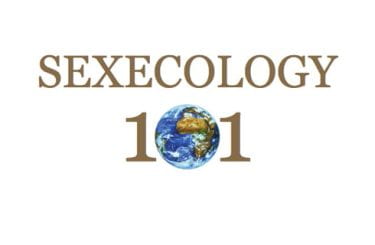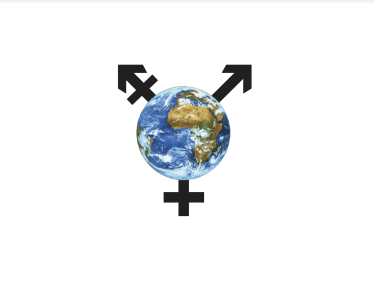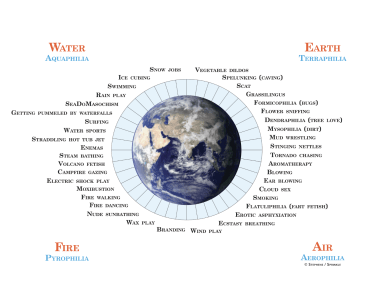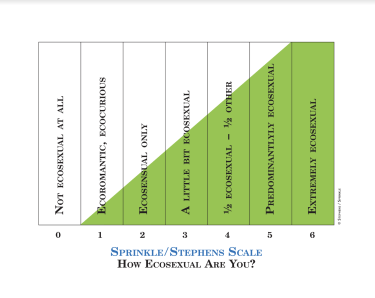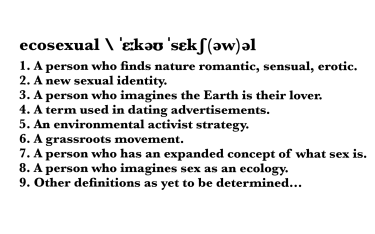
Ecosex 101
We have been researching ecosexuality as a new sexual identity. Here are some basic charts and graphs we made, and images we collected to help illustrate our research. We explain these images in our theater piece, Dirty Sexecology: 25 Ways to Make Love to the Earth.
Click here for an excerpt of the script.
Here is an excerpt from our show, Dirty Sexecology—25 Ways to Make Love to the Earth which explains more about our charts, which we use in our new theater piece.
Setting: Stephens and Sprinkle present their new research at The First International Sexecology Conference, with a slide show behind them.
Annie: TONIGHT we are going to share with you our very important discovery. This discovery is about nothing less than humankind’s relationship with the Earth. Let us explain. Traditionally human kind has generally imagined the Earth in two different ways. First as an ENEMY FORCE to be dominated and controlled. Man VS. Nature!
Beth: Second, the Earth has been imagined as being our MOTHER. Mother Earth. Meaning that “she” that takes care of US. We assume that “she” will breast-feed us forever. By the way, we do realize that the Earth could be imagined as female and/or male. But for the sake of simplicity from here on in, we will privilege the pronoun “she” for the Earth. Plus, as you know, “s/he” includes “he.”
Annie: Herstory proves that we cannot conquer nature. Look at Pompeii, or the San Francisco earthquake in 1906. Seeing the Earth as enemy does not help. And these days the Earth is so used, so abused, and her resources so exploited, that to see the Earth as our MOTHER is to put too much of a burden on her now. We can’t just take, take, take. We must find a new way to relate to the Earth that is more mutual and sustainable.
Beth: We all know that the Earth’s resources are limited! We have polluted our planet with islands of plastic the size of Texas. There’s global warming and the waters are rising. More animal and plant species are becoming extinct every minute. Clearly we’re KILLING our environment! And THAT is what our discovery is all about. We’re proposing third alternative to Earth as Enemy Force, and Earth as Mother.
Annie: It’s a whole NEW paradigm. It’s positively revolutionary! Its Earth as LOVER!
To support this revolutionary approach, we’ve created a new scientific field. Its sexecology! And we’re sex-ecologists. Maybe YOU would like to become sex-ecologists too! We are also ‘ecosexuals.’ Ecosexuals are people who love and care for the Earth, erotically. Ecosexuals take the Earth as their lover.
Beth: WE are ecosexual sexecologists! We’ve been doing some initial research about ecosexuality. First we’ll share with you our findings, then we’ll explore the practice. We are proposing that ecosexual is a sexual identity, such as asexual, bisexual, homosexual, heterosexual and queer. Of course someone can be bi, straight, gay or queer at the same time as being ecosexual. Let us explain further. We have identified four main categories of ecosexual paraphilias, fetishes, or as we prefer to call them— proclivities. These are Earth, Air, Fire and Water.
Beth: For example… Earth proclivities include things like the erotic love of trees, or getting aroused being crawled on by insects—for instance, being covered in butterflies. Some Air proclivities include getting excited in strong winds, or sucking and blowing air in and out of your lover’s mouth. Some Fire proclivities would be nude sun bathing, or getting hot bee’s wax dripped all over your body. Water proclivities would be deriving erotic pleasure while standing under a beautiful waterfall, or enjoying the sensations of skinny-dipping in a tropical ocean.How many of you have laid in the bathtub with your legs spread wide apart with the water splashing down on your vulva? And how many of you have used vegetables as dildos? Be honest. Chart B. We have invented the Sprinkle/Stephens Scale to measure the degree to which a person might identify as ‘ecosexual.’ It’s modeled after the Kinsey Scale. A zero is asexual. A one is sexual but not at all ecosexual. A two is ecoSENSUAL only: meaning you find nature very sensual, but not really sexual. A three is a little bit ecosexual. A four is half ecosexual. A five is predominantly ecosexual. And six is extremely ecosexual. A six is someone who is only aroused by nature. I would identify as a five, and Annie identifies as a four.
Annie: Ok, Lets take a survey right here and now. Take a look at the Sprinkle/Stephens scale. Now that you what ecosexual is how many of you are a zero or 1? Who would now identify as being a 2 to 4? Who is a 5 or 6’s? We find that the number of ecosexuals grows considerably after people are educated about ecosexuality. We gathered a random sample of 1000 people ages 18 to 89 to assess the percentage of people who might be ecosexual. We’ve compared that sample to other sexual identities. 74% identified as heterosexual, 12% homosexual, 5% bisexual, 3% queer, and 30% of people, we have surveyed, identified as being ecosexual… (Script continues.)

